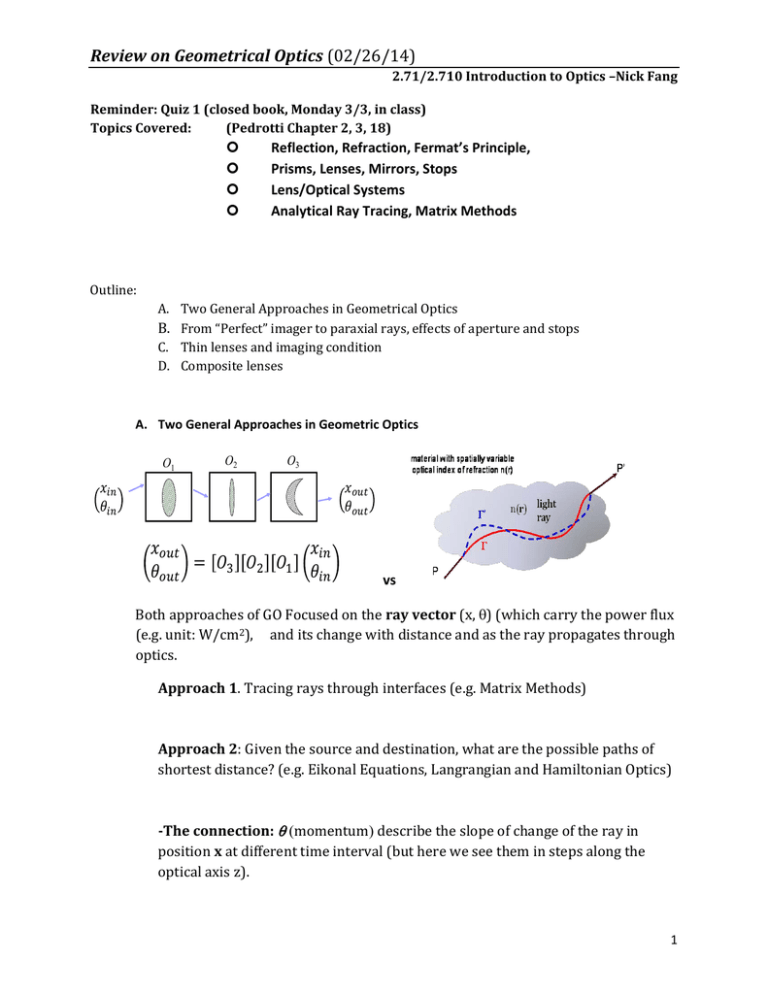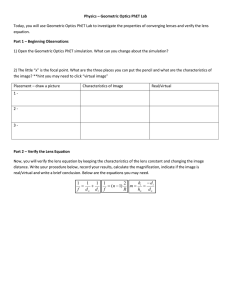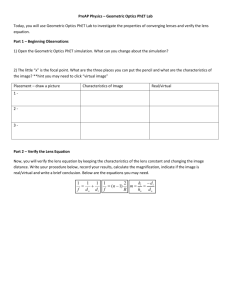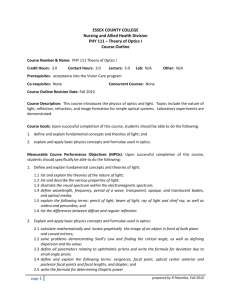
Review on Geometrical Optics (02/26/14)
2.71/2.710 Introduction to Optics –Nick Fang
Reminder: Quiz 1 (closed book, Monday 3/3, in class)
Topics Covered:
(Pedrotti Chapter 2, 3, 18)
Reflection, Refraction, Fermat’s Principle,
Prisms, Lenses, Mirrors, Stops
Lens/Optical Systems
Analytical Ray Tracing, Matrix Methods
Outline:
A. Two General Approaches in Geometrical Optics
B. From “Perfect” imager to paraxial rays, effects of aperture and stops
C. Thin lenses and imaging condition
D. Composite lenses
A. Two General Approaches in Geometric Optics
O1
O2
O3
vs
Both approaches of GO Focused on the ray vector (x, ) (which carry the power flux
(e.g. unit: W/cm2), and its change with distance and as the ray propagates through
optics.
Approach 1. Tracing rays through interfaces (e.g. Matrix Methods)
Approach 2: Given the source and destination, what are the possible paths of
shortest distance? (e.g. Eikonal Equations, Langrangian and Hamiltonian Optics)
-The connection: momentumdescribe the slope of change of the ray in
position x at different time interval (but here we see them in steps along the
optical axis z).
1
Review on Geometrical Optics (02/26/14)
2.71/2.710 Introduction to Optics –Nick Fang
Therefore, the matrix method is similar to Newtonian equations:
(𝑡 + ∆𝑡)
(𝑡) + 𝑣∆𝑡
𝑣(𝑡 + ∆𝑡) 𝑣(𝑡) + 𝑎∆𝑡
(𝑎 𝑖𝑠 𝑎𝑐𝑐𝑒𝑙𝑒𝑟𝑎𝑡𝑖𝑜𝑛; 𝑖𝑛 𝑎 𝑝𝑜𝑡𝑒𝑛𝑡𝑖𝑎𝑙 𝑓𝑖𝑒𝑙𝑑 𝑈( ), 𝑎
We may define Optical Lagrangian: ℒ
𝑛( , 𝑧)√
−
𝑑𝑈
𝑑𝑥
)
+1
𝑑 𝜕ℒ
( )
𝑑𝑧 𝜕
𝜕ℒ
𝜕
LHS: “Potential force”
RHS: “Acceleration”
Or
𝜕𝑛
√
𝜕
𝜕𝑛
𝜕
𝑑
𝑛
𝑑𝑧 √ + 1
+1
1
𝑑
𝑛
+ 1 𝑑𝑧 √ + 1
√
Example: Two Interpretation of Refraction
p
p//
p
p //
n
P’
optical
axis
z
p
x’
'
z’
p
Index n
n’
x
Index n’
interface
vs
h
P
2
Review on Geometrical Optics (02/26/14)
2.71/2.710 Introduction to Optics –Nick Fang
‘(momentum)
(momentum)
x
(location)
1
1
X’
(location)
2 3
2 3
Imaging as a mapping in ray vector spaces
© Pearson Prentice Hall. All rights reserved. This content is excluded from our Creative
Commons license. For more information, see http://ocw.mit.edu/fairuse.
B. From “Perfect” imager to paraxial rays, apertures and stops
S(x) Refractive
index n
F
x
f
air
glass
“Ideal” lens: aspherical!
Spherical lens: only good for small
© Pearson Prentice Hall. All rights reserved. This content is excluded from our Creative
Commons license. For more information, see http://ocw.mit.edu/fairuse.
Problem: spherical aberration (𝑐𝑜𝑠 ≈ 1 −
𝜃2
+
𝜃2
4!
+ ⋯);
Mitigation: use proper apertures to reduce NA (max)
o Effect of Aperture and field stops
3
Review on Geometrical Optics (02/26/14)
2.71/2.710 Introduction to Optics –Nick Fang
NA
entrance
pupil
aperture
stop
exit
pupil
FoV
field
stop
exit
window
entrance
window
Effect of Apertures and stops
‘(momentum)
(momentum)
apertures
x
(location)
X’
(location)
1
1
2 3
Field stops
2 3
4
Review on Geometrical Optics (02/26/14)
2.71/2.710 Introduction to Optics –Nick Fang
C. Thin Lens and Imaging Condition
so
si
Imaging condition:
1 1
+
𝑠
𝑠
1
𝑓
ℎ
ℎ
𝐴
1−
≈
/𝑠
/𝑠0
𝐷
Spatial Magnification:
𝑀≡
𝑠
𝑓
Angular Magnification:
𝑀𝛼 ≡
1−
𝑠
𝑓
D. Composite lens and Principal Planes
E. Typical function of composite lens, and corresponding matrix elements
© Pearson Prentice Hall. All rights reserved. This content is excluded from our Creative
Commons license. For more information, see http://ocw.mit.edu/fairuse.
5
Review on Geometrical Optics (02/26/14)
2.71/2.710 Introduction to Optics –Nick Fang
1st PP
O
ho
object
2nd PP
C
C’
BFP
image
FFP
I
EFL
so
hi
EFL
si
6
Review on Geometrical Optics (02/26/14)
2.71/2.710 Introduction to Optics –Nick Fang
© Pearson Prentice Hall. All rights reserved. This content is excluded from our Creative
Commons license. For more information, see http://ocw.mit.edu/fairuse.
Note: when prisms and mirrors are used in the optical train, consider “unfold” the optical
axis first!
7
Review on Geometrical Optics (02/26/14)
2.71/2.710 Introduction to Optics –Nick Fang
Example 1: Two identical, thin, plano-convex lenses with radii of curvature of 15cm are
situated with their curved surfaces in contact at their centers. The intervening space is
filled with oil, of refractive index n=1.65. The index of the glass is n=1.50. Determine the
focal length of the combination.
Example 2: A Retrofocus Lens. For an object placed at infinity, we need to design a
composite lens system with the following specifications:
The spacing from the front lens to the rear lens is 120 mm.
The working distance (from the rear lens to image plane) is 100 mm.
The effective focal length (EFL) is 60mm.
A. S.
L1
L2
d=120 mm
Image plane
-
BFL=100 mm
a) Assuming all elements are thin lenses, determine the focal length of each
individual lens.
b) Locate the principal planes of the lens system.
c) The aperture stop (A. S.) of this system is located at the rear lens. In order for
the system to operate at Numerical Aperture =1/8, what should be the diameter
of the aperture?
8
MIT OpenCourseWare
http://ocw.mit.edu
2SWLFV
Spring 2014
For information about citing these materials or our Terms of Use, visit: http://ocw.mit.edu/terms.





